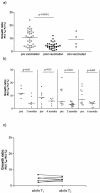Novel human in vitro system for evaluating antimycobacterial vaccines
- PMID: 15501770
- PMCID: PMC522995
- DOI: 10.1128/IAI.72.11.6401-6407.2004
Novel human in vitro system for evaluating antimycobacterial vaccines
Abstract
Major research efforts are directed towards the development of a better antimycobacterial vaccine. But progress in the field of tuberculosis vaccine development has been hampered by the lack of human in vitro models to assess vaccine immunogenicity and efficacy. New candidate vaccines will have to be evaluated against the existing Mycobacterium bovis BCG "gold standard." It is therefore important to understand the type of immune responses elicited by BCG vaccination to enable comparisons with potential new candidates. We used a novel human in vitro whole-blood model, which measures immune responses to mycobacteria by use of reporter gene-tagged BCG (BCG lux), to study immune responses to BCG vaccination in 50 neonates in a setting in Cape Town, Republic of South Africa, where tuberculosis is endemic. BCG vaccination significantly reduced growth of BCG lux in whole blood (prevaccination median growth ratio [GR], 9.6; range, 1.3 to 24; postvaccination median GR, 3.9; range, 0.6 to 12.2 [P < 0.0001]). Growth of BCG lux was better restricted in vaccinated infants than in unvaccinated age-matched controls (n = 4). BCG vaccination induced significantly higher gamma interferon production in response to BCG lux (P < 0.0001) and to purified protein derivative (P = 0.0001). No significant changes in either growth of BCG lux or cytokine production occurred in an adult control group (n = 6) over the study period. The whole-blood luminescence model detects changes in cellular immune responses to mycobacteria induced by BCG vaccination. It is therefore a useful new tool in studying the immunogenicity of newly developed vaccine candidates prior to large field trials assessing efficacy.
Figures



Similar articles
-
[Novel vaccines against M. tuberculosis].Kekkaku. 2006 Dec;81(12):745-51. Kekkaku. 2006. PMID: 17240920 Review. Japanese.
-
The immune response to BCG vaccination of newborns.Ann N Y Acad Sci. 2005 Dec;1062:69-78. doi: 10.1196/annals.1358.010. Ann N Y Acad Sci. 2005. PMID: 16461790 Review.
-
Broad heparin-binding haemagglutinin-specific cytokine and chemokine response in infants following Mycobacterium bovis BCG vaccination.Eur J Immunol. 2012 Sep;42(9):2511-22. doi: 10.1002/eji.201142297. Epub 2012 Aug 1. Eur J Immunol. 2012. PMID: 22653733
-
The efficacy of bacillus Calmette-Guérin vaccination of newborns and infants in the prevention of tuberculosis: meta-analyses of the published literature.Pediatrics. 1995 Jul;96(1 Pt 1):29-35. Pediatrics. 1995. PMID: 7596718
-
Protection against bovine tuberculosis induced by oral vaccination of cattle with Mycobacterium bovis BCG is not enhanced by co-administration of mycobacterial protein vaccines.Vet Immunol Immunopathol. 2011 Dec 15;144(3-4):220-7. doi: 10.1016/j.vetimm.2011.09.005. Epub 2011 Sep 29. Vet Immunol Immunopathol. 2011. PMID: 22005585
Cited by
-
Differential Effect of Viable Versus Necrotic Neutrophils on Mycobacterium tuberculosis Growth and Cytokine Induction in Whole Blood.Front Immunol. 2018 Apr 27;9:903. doi: 10.3389/fimmu.2018.00903. eCollection 2018. Front Immunol. 2018. PMID: 29755473 Free PMC article.
-
Exposure to mycobacteria primes the immune system for evolutionarily diverse heat shock proteins.Infect Immun. 2005 Nov;73(11):7687-96. doi: 10.1128/IAI.73.11.7687-7696.2005. Infect Immun. 2005. PMID: 16239573 Free PMC article.
-
Galleria mellonella - a novel infection model for the Mycobacterium tuberculosis complex.Virulence. 2018;9(1):1126-1137. doi: 10.1080/21505594.2018.1491255. Virulence. 2018. PMID: 30067135 Free PMC article.
-
An Auto-luminescent Fluorescent BCG Whole Blood Assay to Enable Evaluation of Paediatric Mycobacterial Responses Using Minimal Blood Volumes.Front Pediatr. 2019 Apr 30;7:151. doi: 10.3389/fped.2019.00151. eCollection 2019. Front Pediatr. 2019. PMID: 31114771 Free PMC article.
-
In vitro Mycobacterial Growth Inhibition in South Korean Adults With Latent TB Infection.Front Immunol. 2019 Apr 26;10:896. doi: 10.3389/fimmu.2019.00896. eCollection 2019. Front Immunol. 2019. PMID: 31105706 Free PMC article.
References
-
- al-Kassimi, F. A., M. S. al-Hajjaj, I. O. al-Orainey, E. A. Bamgboye. 1995. Does the protective effect of neonatal BCG correlate with vaccine-induced tuberculin reaction? Am. J. Respir. Crit. Care Med. 152:1575-1578. - PubMed
-
- American Thoracic Society. 1981. The tuberculin skin test. Am. Rev. Respir. Dis. 124:356-363.
-
- Black, G. F., R. E. Weir, S. Floyd, L. Bliss, D. K. Warndorff, A. C. Crampin, B. Ngwira, L. Sichali, B. Nazareth, J. M. Blackwell, K. Branson, S. D. Chaguluka, L. Donovan, E. Jarman, E. King, P. E. Fine, and H. M. Dockrell. 2002. BCG-induced increase in interferon-gamma response to mycobacteria antigens and efficacy of BCG vaccination in Malawi and the UK: two randomised controlled studies. Lancet 359:1393-1401. - PubMed
-
- Casanova, J. L., and L. Abel. 2002. Genetic dissection of immunity to mycobacteria: the human model. Annu. Rev. Immunol. 20:581-620. - PubMed
Publication types
MeSH terms
Substances
LinkOut - more resources
Full Text Sources
Other Literature Sources
Medical

